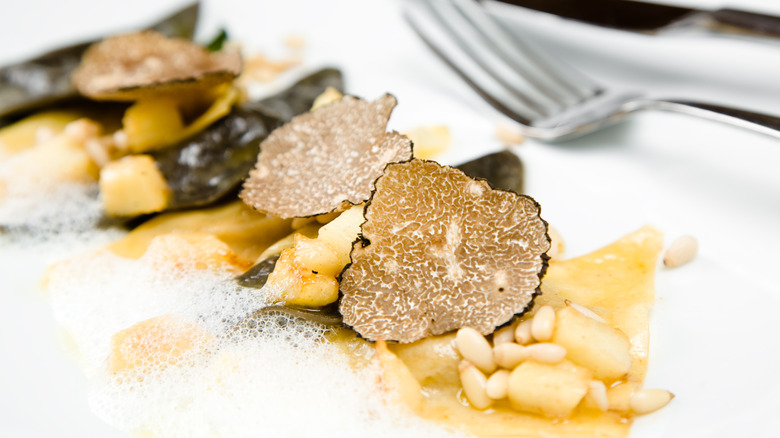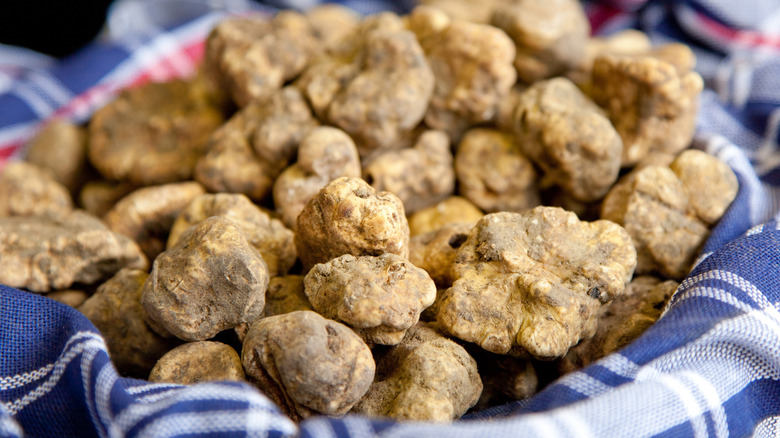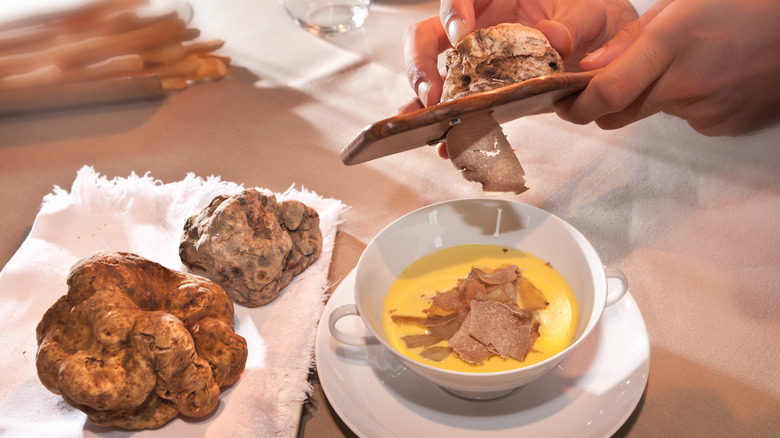How To Tell If You're Eating Fake Truffles At A Restaurant
Like champagne, caviar, and oysters, truffles are just one of those things that automatically exude an aura of wealth and excess. The rare fungi, which are traditionally foraged using dogs or pigs in the forests of France and Italy, are prized for their pungent smell and flavor, which come off as earthy, musky, and downright sexy.
Truffle-flavored and garnished items have continued to pop up on the menus of restaurants around the globe, demanding a crucial question: If truffles are so rare, then how is it that they seem to be everywhere? Why does your local dive bar have truffle fries for $12 when the fungi can cost up to $200 an ounce?
The answer is that you might not actually be eating real truffles. There is a chemical compound called 2,4-dithiapentane whose aroma and taste is an uncanny dead ringer for truffle. The chemical, known as "synthetic truffle," has been used to dupe consumers into thinking they're eating the real thing since the '90s. To tell the difference, you'll have to look at price, smell, and texture.
Start by checking the price
Truffles are normally very expensive because they cannot be cultivated, and they are only native to a few regions. So once found, they must be carefully transported, driving up costs. If truffle hunters want to scale up business, they can't simply plant more truffles. The fungi also have an incredibly short shelf life, and stay fresh for less than a week, making them impossible to stock up on.
With that in mind, the easiest way to know if you are eating real truffles is to look at the price. Does it seem like you're getting a really good deal on that truffle mac and cheese? Then you probably aren't. A simple truffle risotto at a restaurant specializing in truffles will cost at least $65 (and likely closer to $100), so if you're paying $30 for lamb and truffle pasta, you're probably getting truffle oil or truffle butter, which may or may not have ever had contact with a proper truffle.
Also, consider your location. If you are smack dab in the middle of the Périgord region in France, known as the truffle capital of the world, then there's a higher likelihood that what you're getting is fresh and legitimate. Upscale restaurants in major cities like New York or London might also have dedicated sourcing channels during truffle season, but if you're far from truffle country and not near any major culinary distribution routes, you're less likely to get your hands on a true truffle.
How to spot a fake truffle
However, you can be fooled into buying fake truffles even if you're looking at an actual truffle, not just shavings in your restaurant dish or a bottle of truffle oil. There are a few species of fungi that appear similar to truffles, known as false truffles, which are often sold as the real thing. Examples include Scleroderma Polyrhizum and Pisolithus Arhizus, known as Bohemian truffles.
If you want to make sure you're buying and eating real truffles, try the smell test. If they don't have that strong, unmistakable truffle smell, they might not be real. You can also check the texture, which should be firm, with a bumpy exterior, not smooth or spongy.
And keep in mind that even if you do get a real, genuine truffle, you still might be overpaying. The Italian Forestry Corps has documented extensive organized crime networks dedicated to selling mislabeled truffles of uncertain provenance. It's common practice for crooked middlemen to purchase truffles from one region, and sell them under the name of a more prestigious region for a higher price tag.



